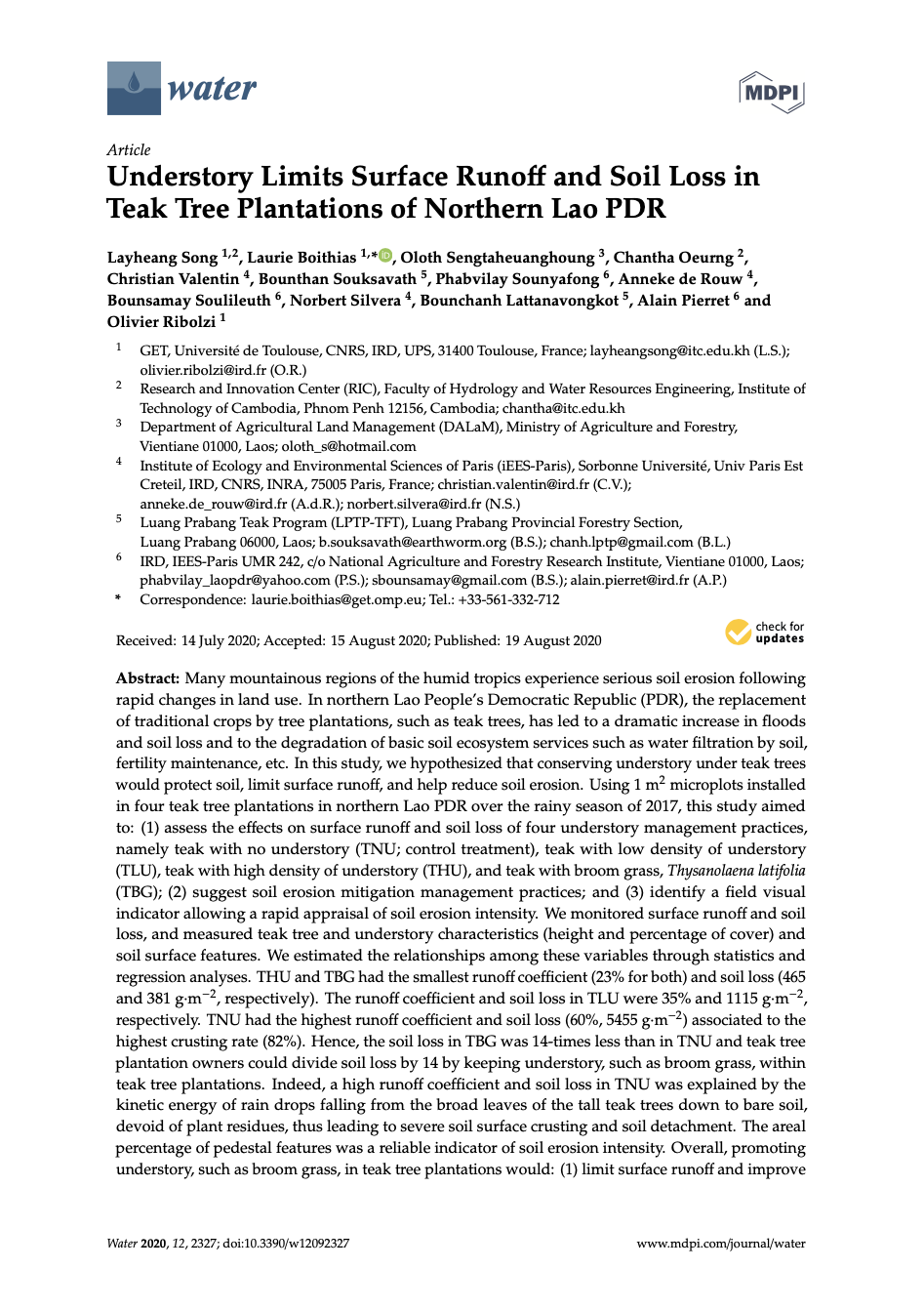
Keyword(s)
Author(s)
Layheang Song, Laurie Boithias, Oloth Sengtaheuanghoung, Chantha Oeurng, Christian Valentin, Bounthan Souksavath, Phabvilay Sounyafong, Anneke de Rouw, Bounsamay Soulileuth, Norbert Silvera, Bounchanh Lattanavongkot, Alain Pierret, Olivier Ribolzi
Country(ies)
Publisher
Published Date
Access
DOI
1) GET, Université de Toulouse, CNRS, IRD, UPS, 31400 Toulouse, France
2) Research and Innovation Center (RIC), Faculty of Hydrology and Water Resources Engineering, Institute of Technology of Cambodia, Phnom Penh 12156, Cambodia
3) Department of Agricultural Land Management (DALaM), Ministry of Agriculture and Forestry, Vientiane 01000, Laos
4) Institute of Ecology and Environmental Sciences of Paris (iEES-Paris), Sorbonne Université, Univ Paris Est Creteil, IRD, CNRS, INRA, 75005 Paris, France
5) Luang Prabang Teak Program (LPTP-TFT), Luang Prabang Provincial Forestry Section, Luang Prabang 06000, Laos
6) IRD, IEES-Paris UMR 242, c/o National Agriculture and Forestry Research Institute, Vientiane 01000, Laos
Many mountainous regions of the humid tropics experience serious soil erosion following rapid changes in land use. In northern Lao People’s Democratic Republic (PDR), the replacement of traditional crops by tree plantations, such as teak trees, has led to a dramatic increase in floods and soil loss and to the degradation of basic soil ecosystem services such as water filtration by soil, fertility maintenance, etc. In this study, we hypothesized that conserving understory under teak trees would protect soil, limit surface runoff, and help reduce soil erosion. Using 1 m2 microplots installed in four teak tree plantations in northern Lao PDR over the rainy season of 2017, this study aimed to: (1) assess the effects on surface runoff and soil loss of four understory management practices, namely teak with no understory (TNU; control treatment), teak with low density of understory (TLU), teak with high density of understory (THU), and teak with broom grass, Thysanolaena latifolia (TBG); (2) suggest soil erosion mitigation management practices; and (3) identify a field visual indicator allowing a rapid appraisal of soil erosion intensity. We monitored surface runoff and soil loss, and measured teak tree and understory characteristics (height and percentage of cover) and soil surface features. We estimated the relationships among these variables through statistics and regression analyses. THU and TBG had the smallest runoff coefficient (23% for both) and soil loss (465 and 381 g·m−2, respectively). The runoff coefficient and soil loss in TLU were 35% and 1115 g·m−2, respectively. TNU had the highest runoff coefficient and soil loss (60%, 5455 g·m−2) associated to the highest crusting rate (82%). Hence, the soil loss in TBG was 14-times less than in TNU and teak tree plantation owners could divide soil loss by 14 by keeping understory, such as broom grass, within teak tree plantations. Indeed, a high runoff coefficient and soil loss in TNU was explained by the kinetic energy of rain drops falling from the broad leaves of the tall teak trees down to bare soil, devoid of plant residues, thus leading to severe soil surface crusting and soil detachment. The areal percentage of pedestal features was a reliable indicator of soil erosion intensity. Overall, promoting understory, such as broom grass, in teak tree plantations would: (1) limit surface runoff and improve soil infiltrability, thus increase soil water stock available for both root absorption and groundwater recharge; and (2) mitigate soil loss while favoring soil fertility conservation.
Cite: Song, L., Boithias, L., Sengtaheuanghoung, O., Oeurng., Valentin., Souksavath, B., Sounyafong, P., Rouw, A., Soulileuth, B., Silvera, N., Lattanavongkot, B., Pierret,A., Ribolzi, O., 2020. Understory Limits Surface Runoff and Soil Loss in Teak Tree Plantations of Northern Lao PDR. Water 12.